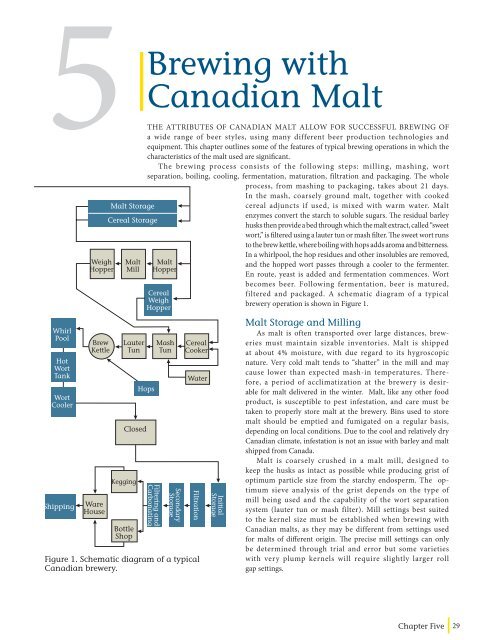MALTING QUALITY TRAITS - Canadian Malting Barley Technical ...
MALTING QUALITY TRAITS - Canadian Malting Barley Technical ...
MALTING QUALITY TRAITS - Canadian Malting Barley Technical ...
You also want an ePaper? Increase the reach of your titles
YUMPU automatically turns print PDFs into web optimized ePapers that Google loves.
5 Brewing<br />
Whirl<br />
Pool<br />
Hot<br />
Wort<br />
Tank<br />
Wort<br />
Cooler<br />
Shipping<br />
Weigh<br />
Hopper<br />
Brew<br />
Kettle<br />
Ware<br />
House<br />
Malt Storage<br />
Cereal Storage<br />
Malt<br />
Mill<br />
Lauter<br />
Tun<br />
Figure 1. Schematic diagram of a typical<br />
<strong>Canadian</strong> brewery.<br />
with<br />
<strong>Canadian</strong> Malt<br />
THE ATTRIBUTES OF CANADIAN MALT ALLOW FOR SUCCESSFUL BREWING OF<br />
a wide range of beer styles, using many different beer production technologies and<br />
equipment. This chapter outlines some of the features of typical brewing operations in which the<br />
characteristics of the malt used are significant.<br />
The brewing process consists of the following steps: milling, mashing, wort<br />
separation, boiling, cooling, fermentation, maturation, filtration and packaging. The whole<br />
process, from mashing to packaging, takes about 21 days.<br />
Malt<br />
Hopper<br />
Cereal<br />
Weigh<br />
Hopper<br />
Hops<br />
Closed<br />
Kegging<br />
Bottle<br />
Shop<br />
Filtering and<br />
Carbonating<br />
Mash<br />
Tun<br />
Secondary<br />
Storage<br />
Cereal<br />
Cooker<br />
Water<br />
Filtration<br />
Initial<br />
Storage<br />
In the mash, coarsely ground malt, together with cooked<br />
cereal adjuncts if used, is mixed with warm water. Malt<br />
enzymes convert the starch to soluble sugars. The residual barley<br />
husks then provide a bed through which the malt extract, called “sweet<br />
wort,” is filtered using a lauter tun or mash filter. The sweet wort runs<br />
to the brew kettle, where boiling with hops adds aroma and bitterness.<br />
In a whirlpool, the hop residues and other insolubles are removed,<br />
and the hopped wort passes through a cooler to the fermenter.<br />
En route, yeast is added and fermentation commences. Wort<br />
becomes beer. Following fermentation, beer is matured,<br />
filtered and packaged. A schematic diagram of a typical<br />
brewery operation is shown in Figure 1.<br />
Malt Storage and Milling<br />
As malt is often transported over large distances, breweries<br />
must maintain sizable inventories. Malt is shipped<br />
at about 4% moisture, with due regard to its hygroscopic<br />
nature. Very cold malt tends to “shatter” in the mill and may<br />
cause lower than expected mash-in temperatures. Therefore,<br />
a period of acclimatization at the brewery is desirable<br />
for malt delivered in the winter. Malt, like any other food<br />
product, is susceptible to pest infestation, and care must be<br />
taken to properly store malt at the brewery. Bins used to store<br />
malt should be emptied and fumigated on a regular basis,<br />
depending on local conditions. Due to the cool and relatively dry<br />
<strong>Canadian</strong> climate, infestation is not an issue with barley and malt<br />
shipped from Canada.<br />
Malt is coarsely crushed in a malt mill, designed to<br />
keep the husks as intact as possible while producing grist of<br />
optimum particle size from the starchy endosperm. The optimum<br />
sieve analysis of the grist depends on the type of<br />
mill being used and the capability of the wort separation<br />
system (lauter tun or mash filter). Mill settings best suited<br />
to the kernel size must be established when brewing with<br />
<strong>Canadian</strong> malts, as they may be different from settings used<br />
for malts of different origin. The precise mill settings can only<br />
be determined through trial and error but some varieties<br />
with very plump kernels will require slightly larger roll<br />
gap settings.<br />
Chapter Five<br />
29


